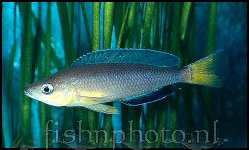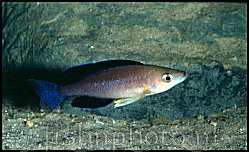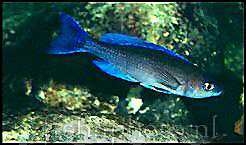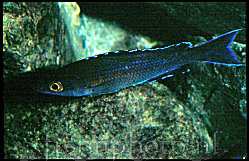Outside
there is nothing to be seen of the difference in the numbers of the vertebras
mentioned before. But Cyprichromis and Paracyprichromis differ from
each other in ecological and in behavior as well so much that the new sub division
seams acceptable also for the layman .
At the first place there are the dichromatic
colors with the male. As far as known up until now this phenomenon only occurs
with representatives of the Genus Cyprichromis ; the males of the same
population are colored totally different. One part of the fishes has a clear yellow
the other part a blue caudal fin. This phenomenon rather uncommon at the cichlids
from lake Tanganyika is partly due to the popularity of these cichlids. One can
only guess at the background of it, f.i. how it is inherited or which is the function
of it.
Ecology and way of life.
Because these animals demand explicit
requirements to their surroundings that only occur at specific parts of the shore,
and because their occurrence often is limited at the deeper regions only they
are to be traced only hardly and without a diving equipment scarcely to be caught
or to be observed.
Depending on the species the upper frontier of their distribution
at a depth of three till fifteen meters. Especial Paracyprichromis nigripinnis
seems to prefer a larger depth where as P. brieni is to be found a little
less deep. They occur exclusively above a rocky ground . There they live socially
in large coherent groups lied to a particular area. Cyprichromis leptosoma
often are found in schools consisting of more than thousands individuals; specially
female animals that were breeding eggs or with a pharynx full of young ones Only
at the margins of this formations were met also great numbers of males that were
courting the females or were involved in mutual ritual fights. Although Paracyprichromis
brieni sometimes occur at the finding places of Cyprichromis-specimen, the
representatives of both genus a distinct preferences for very different rooms
for living. When P. brieni seldom moves away from the bottom, the Cyprichromis-specimen
preferably stay at a larger distance up from the |
substrate
in the free water. Vertical rocks along the bottom part of sheer cliffs for
Cyprichromis leptosoma are distinct their favorite stay. All sardine cichlids
are planktonivore , that feed themselves with little entomostracans out of the
family of Cyclops and with planktonic algae as well (BÜSCHER, 1991). Their
mouth. which they can extend like a kind of telescope is a kind of special adaptation
to this way of feeding themselves. In the aquarium we can also see this when we
feed them with daphnia or the nauplien of Artemia. In this way the sardine cichlids
of lake Tanganyika accomplish the same role and position like the Utaka's of the
genus Copadichromis in Lake Malawi. About this cichlids that are studied
well, one knows that they live preferably in tremendous large flocks against the
vertical walls of the underwater reefs while there their food is supplied to them
by a stream. (FRYER & ILES, 1972). One supposes that on places in lake Tanganyika
at the steep shores the sardine cichlids occur in the large numbers mentioned
before the same ecological circumstances are found.
Reproduction
All sardine cichlids are maternal mouthbreeders; that means that the spawn immediately
after secretion is taken in the mouth by the female and is bred there. While the
eggs are very great consisting for the mayor part of yolk, it last also at higher
temperatures longer than four weeks, before the offspring that at that moment
is already 12 mms in length are released from the mouth. Observations in the aquarium
proved Paracipichromidi to be substrate breeder's whereas Cyprichromidi
are free spawners. Both of the Paracyprichromis-specimen preferably put their
eggs at perpendicular surfaces. Female take a upside down position and wait as
long as the spawned egg that sinks between her and the substrate reaches the mouth.
to suck it up it than. The Cyprichromis-specimen on the other hand spawn in the
open water far from the substrate. The eggs are secreted one by one and sink down
After one egg has been excreted the female turns around at lighting speed to follow
the sinking egg and to suck it in in the same way as food wood be taken |



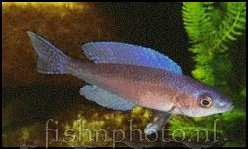
![]() Cyprichromis leptosoma Malasa bl..
Cyprichromis leptosoma Malasa bl..![]() Cyprichromis leptosoma Jumbo Chaitika
Cyprichromis leptosoma Jumbo Chaitika![]() Cyprichromis leptosoma
Cyprichromis leptosoma![]()
![]()
